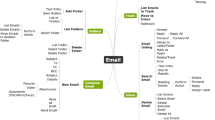Abstract
Usability tests are a part of user-centered design. Usability testing with disabled people is necessary, if they are among the potential users. Several researchers have already investigated usability methods with sighted people. However, research with blind users is insufficient, for example, due to different knowledge on the use of assistive technologies and the ability to analyze usability issues from inspection of non-visual output of assistive devices. From here, the authors aspire to extend theory and practice by investigating four usability methods involving the blind, visually impaired and sighted people. These usability methods comprise of local test, synchronous remote test, tactile paper prototyping and computer-based prototyping. In terms of effectiveness of evaluation and the experience of participants and the facilitator, local tests were compared with synchronous remote tests and tactile paper prototyping with computer-based prototyping. Through the comparison of local and synchronous remote tests, it has been found that the number of usability problems uncovered in different categories with both approaches was comparable. In terms of task completion time, there is a significant difference for blind participants, but not for the visually impaired and sighted. Most of the blind and visually impaired participants prefer the local test. As for the comparison of tactile paper prototyping and computer-based prototyping, it has been revealed that tactile paper prototyping provides a better overview of an application while the interaction with computer-based prototypes is closer to reality. Problems regarding the planning and conducting of these methods as they arise in particular with blind people were also discussed. Based on the authors’ experiences, recommendations were provided for dealing with these problems from both the technical and the organization perspectives.

















Similar content being viewed by others
Notes
Fidelity means how similar are the produced prototypes to the final product.
References
Mayhew, D.: The Usability Engineering Lifecycle—A practitioner’s Handbook For User Interface Design. Morgan Kaufmann, San Francisco (1999). ISBN 1558605614
Miao, M., Köhlmann, W., Schiewe, M., Weber, G.: Tactile paper prototyping with blind subjects. In: Haptic and Audio Interaction Design (HAID), Dresden, pp. 81–90. Springer, Berlin, Heidelberg (2009)
Magnusson, C., Brewster, S. (eds.): Guidelines for Haptic Lo-Fi Prototyping. Workshop, NordiCHI 2008, Lund, Sweden, 19 Now. (2008)
Rudd, J., Stern, K., Isensee, S.: Low vs. high-fidelity prototyping debate. In: Interactions 3, Nr. 1, pp. 76–85 (1996)
ISO 9241-171: Ergonomics of Human-System Interaction—Part 171: Guidance on Software Accessibility (2009)
Web Content Accessibility Guidelines (WCAG) 2.0, W3C Recommendation 11 December 2008. http://www.w3.org/TR/WCAG20/
Virzi, R.A., Sokolov, J.L., Karis, D.: Usability problem identification using both low- and high-fidelity prototypes. In: CHI’96: Proceedings of the SIGCHI Conference on Human Factors in Computing Systems, pp. 236–243. New York, USA (1996)
Miriam, W., James, A.L.: High-fidelity or low-fidelity, paper or computer? Choosing attributes when testing web prototypes. In: Proceedings of the Human Factors and Ergonomics Society, pp. 661–665 (2002)
Petrie, H., Hamilton, F., King, N. et al.: Remote usability evaluation with disabled people. In: Proceedings of CHI, pp. 1133–1141. ACM Press (2006)
Hartson, H.R., Castillo J.C., Kelso, J., Kamler, J., Neale, W.C.: Remote evaluation: the network as an extension of the usability laboratory. In: Proceedings of CHI Conference on Human Factors in Computing Systems ACM, pp. 228–235. New York (1996)
Selvaraj, P.: Comparative Study of Synchronous Remote and Traditional In-Lab Usability Evaluation Methods. Master of Science Thesis. The Virginia Polytechnic Institute and State University (2004)
Hartson, H.R., Castillo, J.C.: Remote evaluation for post-deployment usability improvement. Proceedings of the Working Conference on Advanced Visual Interfaces, pp. 22–29. L’Aquila, Italy (1998)
Brush, A.J.B., Ames, M., Davis, J.: A comparison of synchronous remote and local usability studies for an expert interface. Proceeding of CHI, pp. 1179–1182. Austria, Vienna (2004)
Johnson, J.: Don’ts and Do’s for Software Developers and Web Designers, 1st edn. Morgan Kaufmann (2000)
Nielsen, J.: Usability Engineering. Morgen Kaufmann (1993)
Sefelin, R.: Comparison of Paper- and Computer Based Low-Fidelity Prototypes/Center for Usability Research & Engineering (CURE). Research report (2002)
Nielsen, J., Loranger, H.: Prioritizing Web Usability. New Riders Press, Berkeley (2006)
Acknowledgments
The authors would like to thank the participants and collaborators for spending their time on this study.
Author information
Authors and Affiliations
Corresponding author
Rights and permissions
About this article
Cite this article
Miao, M., Pham, H.A., Friebe, J. et al. Contrasting usability evaluation methods with blind users. Univ Access Inf Soc 15, 63–76 (2016). https://doi.org/10.1007/s10209-014-0378-8
Published:
Issue Date:
DOI: https://doi.org/10.1007/s10209-014-0378-8




